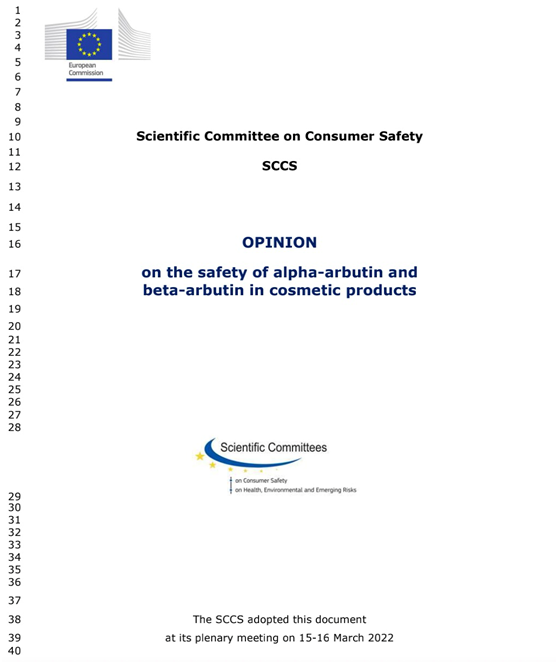On 15 March 2022, the European Scientific Committee for Consumer Safety (SCCS) issued draft opinion on the safety of Alpha-Arbutin and Beta-Arbutin, in which it concludes that without data on Hydroquinone release and its ultimate destination, it is not possible to determine the safe concentration of any Arbutin in cosmetics. The draft opinion is open for public comment until May 27, 2022.

Arbutin can inhibit tyrosinase activity effectively by directly binding itself to tyrosinase, competing for the binding site of Dopa, blocking the synthesis of Dopa and Dopa Quinine, and thus interfering with melanocytes and inhibit the production of melanin. At the same time, it also has the function of desalinating melanin that has been formed and reducing the deposition of skin pigment. It is widely used in whitening products. However, Arbutin may be converted to Hydroquinone under conditions such as low pH, high temperature, UV irradiation and other conditions, or under the action of human skin microorganisms or glucosidase, resulting in potential risks of sensitization, genotoxicity or carcinogenesis. Therefore, its security receives the media and the consumer's attention.
Based on differences in chemical structure, Arbutin can be divided into α -arbutin, β -arbutin and Deoxyarbutin. CAS Number of Alpha-Arbutin is 84380-018. CAS Number of Beta-arbutin is 497-76-7. β-Arbutin is cheap and widely used in cosmetics; α -Arbutin and Deoxyarbutin are new whitening ingredients, which are better than β -arbutin in whitening effect, but less used than β -arbutin. Deoxyarbutin, or Tetrahydropyranoxyphenol, Deoxyarbutin, CAS No. 53936-56-4, has been banned in the EU since 26 July 2021.
SCCS has previously assessed the safety of both α -Arbutin and β -Arbutin in SCCS/1552/15 and SCCS/1550/15, respectively. The results are as follows:
1. The use of α -Arbutin in cosmetics is safe for consumers, with concentrations up to 2% in face creams and 0.5% in moisturizers.
2. Up to 7% of β -Arbutin in creams is safe for consumers if hydroquinone levels in cosmetic formulations are kept below 1 ppm.
Nevertheless, SCCS stressed in both opinions that the safety of potential Hydroquinone-releasing substances in cosmetics has not been assessed when used in combination. In the latest draft SCCS/1642/22, it was concluded that without data on Hydroquinone release and its ultimate destination, it is impossible to determine a safe concentration of Arbutin for any of the cosmetics.
Hydroquinone (CAS No. 123-31-9) is currently regulated and assessed for limited use in artificial nail systems in the EU, with a maximum concentration of not more than 0.02% in finished products. The evaluation of hydroquinone issued by Cosmetic Ingredient Review (CIR) in 2015 concluded that hydroquinone is safe for use in hair colorants and artificial nail systems at a maximum concentration of 1%, but should not be used in leave-on cosmetics. It is prohibited in China and Korea. It can be used as a hair dye in Japan.
Information of Arbutin can be found in China CosIng Database, a cosmetic raw material database independently developed by CIRS Group.
If you have any needs or questions, please contact us at service@cirs-group.com.
Further Information

